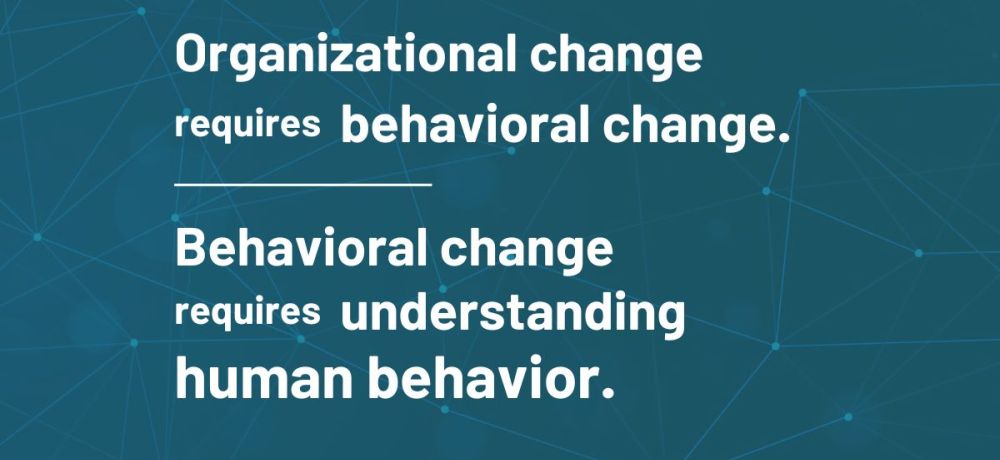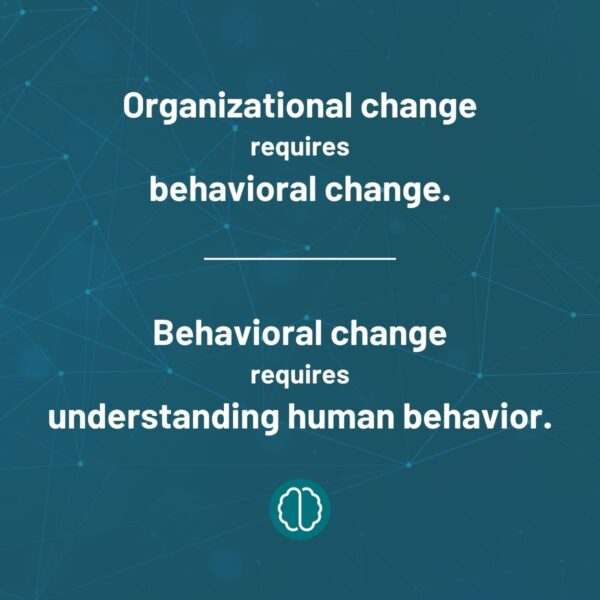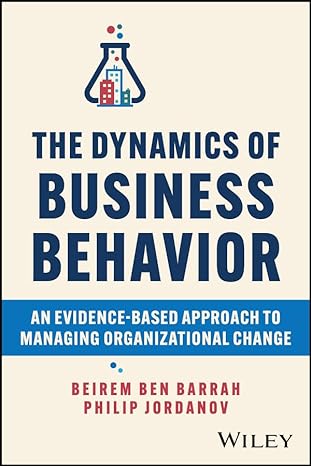
Our Core Change Thesis: Why BeSci for OCM?
We wrote this article to provide context on the core change thesis behind Neurofied and to answer the question of why we wrote our book ‘The Dynamics of Business Behavior: An Evidence-Based Approach to Managing Organizational Change‘. Why is behavioral science (BeSci) such an underutilized but powerful tool in the toolbox of change managers and leaders? And what does it look like when BeSci is applied effectively for organizational change management (OCM)? Read the answers below!
Our Core Change Thesis
How do you effectively drive organizational change? Our thesis is simple: organizational change requires behavioral change, which in turn, requires a nuanced understanding of human behavior. In other words, change managers and leaders must grasp the fundamentals of behavioral science to drive change successfully. After all, most obstacles and challenges in organizational change have a behavioral root cause.
Change only happens when people alter their behavior and do something differently tomorrow than they did today. This principle applies across the board—whether in digital transformations, cultural shifts, or hybrid working environments. However, behavior is complex, especially in the diverse and unique contexts that characterize most organizations. Fortunately, behavioral science offers a way to understand and influence this complexity effectively.

Why Behavioral Science Matters in Change Management
The human brain is wired to respond to change in predictable ways. Resistance, engagement, motivation, adoption, and regression to old habits are all deeply rooted in psychology. Many of these predictable responses can be explained by heuristics and biases—unconscious patterns in our thinking that skew our judgment. For instance, the planning fallacy causes us to underestimate the resources and time required for projects, while reactance leads us to resist changes that feel imposed.
However, remembering hundreds of biases isn’t the solution. Instead, we need to acknowledge that biases, and many other behavioral drivers, are inherent in human decision-making and learn to work with them. This is where a behaviorally informed approach comes into play.
Behaviorally Informed Change Management
To better understand what we mean with behaviorally informed change management, let’s compare two fictional companies both aiming to become more collaborative, inclusive, and entrepreneurial. Company A takes a probably recognizable general approach to change. Company B takes an approach to change more informed by behavioral science.
Company A’s common approach to change
Company A’s leadership team, inspired by a recent seminar, decides to promote collaboration, inclusivity, and entrepreneurship across the organization. They roll out the initiative with town halls, emails, and posters, instructing middle management to integrate these values into daily operations. However, the directives are vague, and each department is left to interpret what these values mean on their own.
The results are predictable. Some employees think collaboration means more meetings, while others believe it’s about open communication. Inclusivity is interpreted as anything from hiring more diverse talent to being polite in meetings. Entrepreneurship ranges from taking risks to launching new projects without guidelines. The lack of clear direction leads to confusion and inefficiency. Employees are unsure if they’re meeting expectations, causing some to resist the changes and others to overcompensate.
In working with our clients, we found that change methods resembling Company A’s tend to be more likely to fail because they are built on abstract ideals without concrete, measurable behaviors. That’s why our core change thesis resonates more with that of…
Company B’s behaviorally informed approach to change
Company B takes a different route. Recognizing that values like collaboration, inclusion, and entrepreneurship can be interpreted differently by various people, they start by defining these values in actionable terms. They focus on specific behaviors that can be observed and replicated.
For instance, in Company B, collaboration means actively seeking input before making decisions. Inclusivity is ensured by structuring meetings so that all voices are heard. Entrepreneurship involves regularly pitching new ideas for process improvements. These behaviors are communicated clearly and consistently across the organization.
Each department tailors these behaviors to their specific context. In sales, collaboration might involve joint client meetings between sales and support teams. In R&D, entrepreneurship could mean running pilot projects on new ideas with a dedicated budget. By defining and reinforcing these behaviors, Company B ensures that everyone is aligned and knows exactly what is expected of them.

Anchoring Change in Behavior
One aspect of our core change thesis is that to truly change an organization, you must change behavior, and to change behavior, you must change the environment. This principle has been echoed across the behavioral sciences for decades. Defining desired actions is essential, but the real challenge lies in re-shaping the environment in which change needs to occur. Changing the environment has proven to be more effective than simply telling employees to act differently or providing training.
For instance, to boost collaboration, cultivate a culture of growth mindset where continuous learning and shared goals are prioritized. To foster entrepreneurship, use a Go-to-Gemba approach, where leaders regularly visit the frontlines to understand challenges and encourage innovative solutions. For inclusivity, create psychological safety by ensuring all team members feel safe to speak up and share their ideas without fear of judgment.
Book: The Dynamics of Business Behavior
Our recently published book The Dynamics of Business Behavior explores this core change thesis through 18 evidence-based, step-by-step interventions that empower you to change behavior by changing the environment. These interventions cover six key areas of change management: planning & risk management, narrative & communication, leadership support, stakeholder engagement, measuring change, and learning & development.
As a manager or leader, your role is to drive change. Whether you’re leading a team, managing a department, or guiding an entire organization, your success depends on influencing behavior. This book, grounded in insights from over 40 interviews with corporate change leaders in global organizations, offers practical, science-backed strategies to help you do just that.
It equips you with the tools and mindset to master and navigate the science and art of change management leading to sustained and human-centric organizational change.
We hope you found this article on our core change thesis useful and that you learned more about why behavioral science is so powerful for managing organizational change. If you’re looking for a behavioral business partner to drive organizational change, we’re happy to schedule a call. Want to learn more about the application of brain and behavioral insights in management, HR, growth and innovation? Read our blog or view our YouTube channel!
About Neurofied
Neurofied is a behavioral science company specialized in training, consulting, and change management. We help organizations drive evidence-based and human-centric change with insights and interventions from behavioral psychology and neuroscience. Consider us your behavioral business partner who helps you build behavioral change capabilities internally.
Since 2018, we have trained thousands of professionals and worked with over 100 management, HR, growth, and innovation teams of organizations such as Johnson & Johnson, KPMG, Deloitte, Novo Nordisk, ABN AMRO, and the Dutch government. We are also frequent speakers at universities and conferences.
Our mission is to democratize the value of behavioral science for teams and organizations. If you have any challenges in your organization that could use a behavioral perspective, feel free to contact us here!
